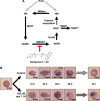Reconstruction and flux-balance analysis of the Plasmodium falciparum metabolic network
- PMID: 20823846
- PMCID: PMC2964117
- DOI: 10.1038/msb.2010.60
Reconstruction and flux-balance analysis of the Plasmodium falciparum metabolic network
Abstract
Genome-scale metabolic reconstructions can serve as important tools for hypothesis generation and high-throughput data integration. Here, we present a metabolic network reconstruction and flux-balance analysis (FBA) of Plasmodium falciparum, the primary agent of malaria. The compartmentalized metabolic network accounts for 1001 reactions and 616 metabolites. Enzyme-gene associations were established for 366 genes and 75% of all enzymatic reactions. Compared with other microbes, the P. falciparum metabolic network contains a relatively high number of essential genes, suggesting little redundancy of the parasite metabolism. The model was able to reproduce phenotypes of experimental gene knockout and drug inhibition assays with up to 90% accuracy. Moreover, using constraints based on gene-expression data, the model was able to predict the direction of concentration changes for external metabolites with 70% accuracy. Using FBA of the reconstructed network, we identified 40 enzymatic drug targets (i.e. in silico essential genes), with no or very low sequence identity to human proteins. To demonstrate that the model can be used to make clinically relevant predictions, we experimentally tested one of the identified drug targets, nicotinate mononucleotide adenylyltransferase, using a recently discovered small-molecule inhibitor.
Conflict of interest statement
The authors declare that they have no conflict of interest.
Figures



References
-
- Aurrecoechea C, Brestelli J, Brunk BP, Dommer J, Fischer S, Gajria B, Gao X, Gingle A, Grant G, Harb OS, Heiges M, Innamorato F, Iodice J, Kissinger JC, Kraemer E, Li W, Miller JA, Nayak V, Pennington C, Pinney DF et al. (2009) PlasmoDB: a functional genomic database for malaria parasites. Nucleic Acids Res 37: D539–D543 - PMC - PubMed
-
- Baird JK (2005) Effectiveness of antimalarial drugs. N Engl J Med 352: 1565–1577 - PubMed
-
- Becker SA, Feist AM, Mo ML, Hannum G, Palsson BO, Herrgard MJ (2007) Quantitative prediction of cellular metabolism with constraint-based models: the COBRA Toolbox. Nat Protoc 2: 727–738 - PubMed
-
- Berwal R, Gopalan N, Chandel K, Prasad GB, Prakash S (2008) Plasmodium falciparum: enhanced soluble expression, purification and biochemical characterization of lactate dehydrogenase. Exp Parasitol 120: 135–141 - PubMed
Publication types
MeSH terms
Grants and funding
LinkOut - more resources
Full Text Sources
Other Literature Sources
Molecular Biology Databases

